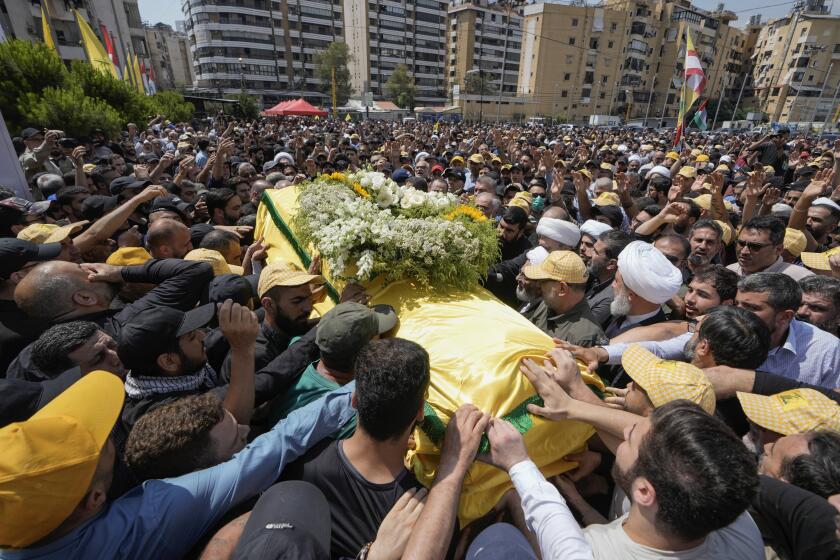SWAT to get female trainee
A highly regarded female police officer has been accepted into the training program for the Los Angeles Police Department’s SWAT unit, clearing a major hurdle toward becoming the first woman officer to join the elite, insular group since its formation more than 35 years ago.
Jennifer Grasso, 36, is one of 13 LAPD officers selected for spots in the department’s 12-week training school, which is scheduled to begin on Monday, according to an internal LAPD email obtained by The Times.
Grasso and the rest of the hopefuls were chosen amid controversy over a newly devised regimen that did away with many grueling endurance tests and exacting simulation exercises that had been used to pre-qualify candidates for Special Weapons and Tactics Team training in the past. The new selection criteria angered many current SWAT officers, who accused Police Chief William J. Bratton and his command staff of watering down the process in order to make it easier for a woman to join the demanding unit, which specializes in resolving standoffs with barricaded suspects and other high-risk operations.
But it appears Grasso has avoided the uncomfortable prospect of coming into SWAT school under a cloud of suspicion. Several SWAT officers, who spoke on the condition that their names not be used because they are not authorized to discuss the matter, said they continue to harbor doubts about the new tests, but are impressed with Grasso and would welcome her onto the team.
“Physically, she’s a dynamo and tactically she’s very solid,” said one SWAT veteran. “She’d be a good selection.”
Grasso declined to be interviewed, but her supervisor, Sgt. Andrea Balter, said Grasso ranks as one of the most impressive officers in C Platoon, another specialized unit in the department’s Metro Division that is often deployed to quell violent crime. Few in the unit make more arrests than Grasso, who, with her partner, is known particularly for gun seizures, Balter said.
“I can’t sing her praises nearly enough,” said Balter. “She is completely committed to the community -- the city -- and to putting bad guys in jail.”
Grasso won the hard-earned praise of current SWAT officers in large part because of her strong performance during tryouts last year. She was nearing acceptance to SWAT school when she badly injured her knee during one of the final tests on a Marine obstacle course at Camp Pendleton. If she had not proved her mettle then, several SWAT officers said, they would be more skeptical of Grasso’s abilities.
It was Grasso’s injury and similar ones suffered by her male counterparts that led department officials, in part, to question whether the punishing Marine courses were excessively arduous for vetting SWAT prospects. A panel of outside experts convened by Bratton to examine SWAT practices also pushed the department to change, concluding that the old tests were “over-emphasizing physical prowess and tactical acumen.”
The subsequent decision by Bratton and his commanders to amend the SWAT selection criteria set off strong protests by SWAT members, who said the tests were needed to determine whether an officer could handle the stress and demands of the job. The Police Protective League, which represents the department’s 9,300 rank-and-file officers, also intervened, accusing the department in an unfair labor practices claim of failing to consult the union before making the changes.
Keen to counter barbs this week by Bratton that the union has been more interested in protecting the status quo than in the rights of female officers, union President Tim Sands said Grasso is “very highly qualified and I wish her the best of luck.”
Bratton, who could not be reached for comment, and SWAT supervisors have refused to discuss the details of the new selection criteria until the department’s civilian oversight commission is briefed on them. Bratton has nonetheless made clear his displeasure that no woman has ever served in SWAT since its official formation in 1971, and his determination to bring an end to the remaining bastions of male dominance in the department before he departs.
This year, Grasso and the other SWAT applicants had to pass a long-standing physical fitness test that includes a three-mile run, sit-ups, push-ups, pull-ups and an obstacle course. They also underwent oral exams and background checks, according to department officials and current SWAT officers who had been briefed on the changes.
Admission to SWAT school, and even successful completion of the training, does not guarantee Grasso or the others accepted to the school one of the 60 places in the unit. Balter and others said there are reportedly only about six open spots; it is unclear whether the candidates will be winnowed during the training or placed on a waiting list.
Grasso’s push to break into SWAT resonated with Nina Acosta, who in 1994 sued the LAPD, saying that she had been unfairly denied admission to the unit because of her gender. The department eventually agreed to let in Acosta, who at the time had the married name Damianakes, but she refused and resigned from the force altogether.
“It’s about time,” she said. “I hope the department supports her 100%. And I hope she has nerves of steel.”
--
More to Read
Sign up for Essential California
The most important California stories and recommendations in your inbox every morning.
You may occasionally receive promotional content from the Los Angeles Times.











